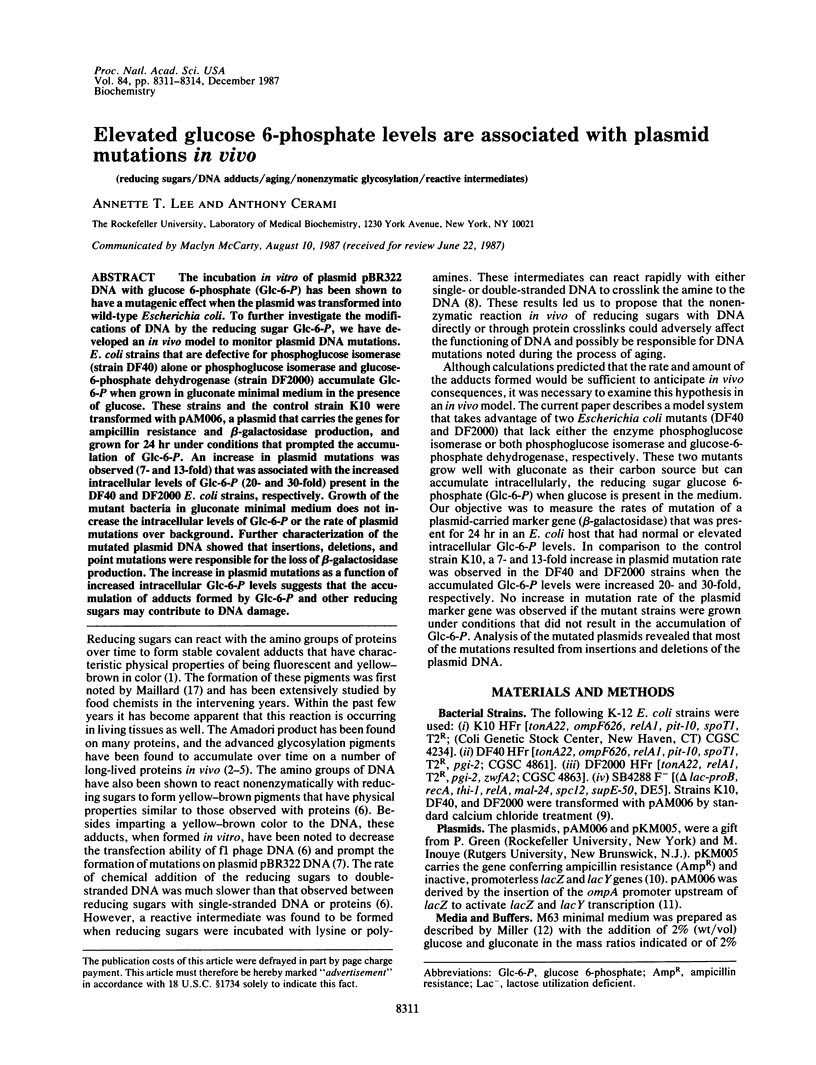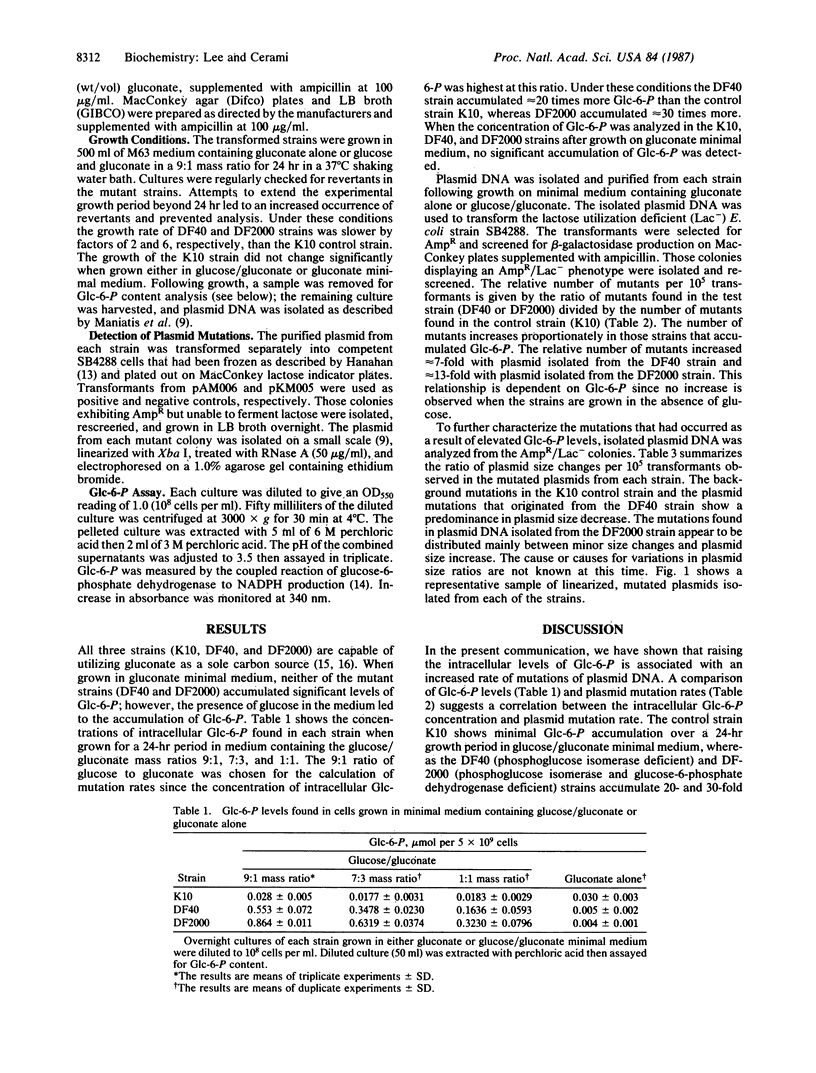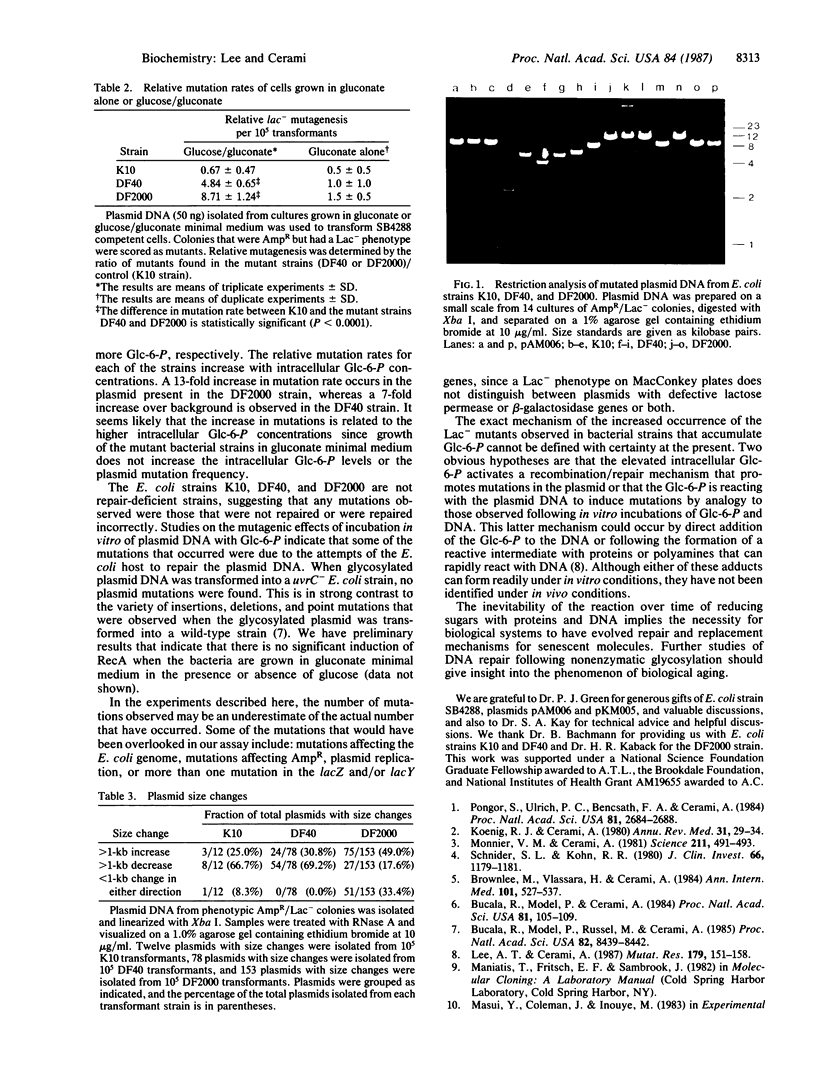Abstract
The incubation in vitro of plasmid pBR322 DNA with glucose 6-phosphate (Glc-6-P) has been shown to have a mutagenic effect when the plasmid was transformed into wild-type Escherichia coli. To further investigate the modifications of DNA by the reducing sugar Glc-6-P, we have developed an in vivo model to monitor plasmid DNA mutations. E. coli strains that are defective for phosphoglucose isomerase (strain DF40) alone or phosphoglucose isomerase and glucose-6-phosphate dehydrogenase (strain DF2000) accumulate Glc-6-P when grown in gluconate minimal medium in the presence of glucose. These strains and the control strain K10 were transformed with pAM006, a plasmid that carries the genes for ampicillin resistance and beta-galactosidase production, and grown for 24 hr under conditions that prompted the accumulation of Glc-6-P. An increase in plasmid mutations was observed (7- and 13-fold) that was associated with the increased intracellular levels of Glc-6-P (20- and 30-fold) present in the DF40 and DF2000 E. coli strains, respectively. Growth of the mutant bacteria in gluconate minimal medium does not increase the intracellular levels of Glc-6-P or the rate of plasmid mutations over background. Further characterization of the mutated plasmid DNA showed that insertions, deletions, and point mutations were responsible for the loss of beta-galactosidase production. The increase in plasmid mutations as a function of increased intracellular Glc-6-P levels suggests that the accumulation of adducts formed by Glc-6-P and other reducing sugars may contribute to DNA damage.
Full text
PDF



Images in this article
Selected References
These references are in PubMed. This may not be the complete list of references from this article.
- Brownlee M., Vlassara H., Cerami A. Nonenzymatic glycosylation and the pathogenesis of diabetic complications. Ann Intern Med. 1984 Oct;101(4):527–537. doi: 10.7326/0003-4819-101-4-527. [DOI] [PubMed] [Google Scholar]
- Bucala R., Model P., Cerami A. Modification of DNA by reducing sugars: a possible mechanism for nucleic acid aging and age-related dysfunction in gene expression. Proc Natl Acad Sci U S A. 1984 Jan;81(1):105–109. doi: 10.1073/pnas.81.1.105. [DOI] [PMC free article] [PubMed] [Google Scholar]
- Bucala R., Model P., Russel M., Cerami A. Modification of DNA by glucose 6-phosphate induces DNA rearrangements in an Escherichia coli plasmid. Proc Natl Acad Sci U S A. 1985 Dec;82(24):8439–8442. doi: 10.1073/pnas.82.24.8439. [DOI] [PMC free article] [PubMed] [Google Scholar]
- Fraenkel D. G., Levisohn S. R. Glucose and gluconate metabolism in an Escherichia coli mutant lacking phosphoglucose isomerase. J Bacteriol. 1967 May;93(5):1571–1578. doi: 10.1128/jb.93.5.1571-1578.1967. [DOI] [PMC free article] [PubMed] [Google Scholar]
- Fraenkel D. G. Selection of Escherichia coli mutants lacking glucose-6-phosphate dehydrogenase or gluconate-6-phosphate dehydrogenase. J Bacteriol. 1968 Apr;95(4):1267–1271. doi: 10.1128/jb.95.4.1267-1271.1968. [DOI] [PMC free article] [PubMed] [Google Scholar]
- Koenig R. J., Cerami A. Hemoglobin A Ic and diabetes mellitus. Annu Rev Med. 1980;31:29–34. doi: 10.1146/annurev.me.31.020180.000333. [DOI] [PubMed] [Google Scholar]
- Lee A. T., Cerami A. The formation of reactive intermediate(s) of glucose 6-phosphate and lysine capable of rapidly reacting with DNA. Mutat Res. 1987 Aug;179(2):151–158. doi: 10.1016/0027-5107(87)90305-8. [DOI] [PubMed] [Google Scholar]
- Monnier V. M., Cerami A. Nonenzymatic browning in vivo: possible process for aging of long-lived proteins. Science. 1981 Jan 30;211(4481):491–493. doi: 10.1126/science.6779377. [DOI] [PubMed] [Google Scholar]
- Pongor S., Ulrich P. C., Bencsath F. A., Cerami A. Aging of proteins: isolation and identification of a fluorescent chromophore from the reaction of polypeptides with glucose. Proc Natl Acad Sci U S A. 1984 May;81(9):2684–2688. doi: 10.1073/pnas.81.9.2684. [DOI] [PMC free article] [PubMed] [Google Scholar]
- Schnider S. L., Kohn R. R. Glucosylation of human collagen in aging and diabetes mellitus. J Clin Invest. 1980 Nov;66(5):1179–1181. doi: 10.1172/JCI109950. [DOI] [PMC free article] [PubMed] [Google Scholar]



